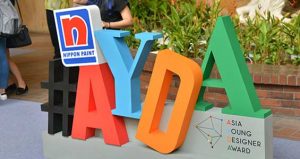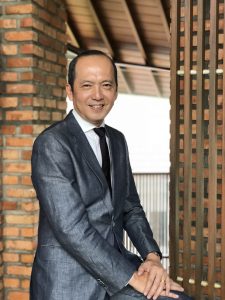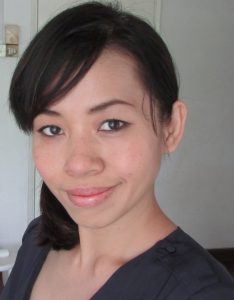Launched in 2008, the Asia Young Designer Awards (AYDA) was a vision by Nippon Paint to nurture the next generation of design talents in the country. The significance of this vision is for the betterment of the architectural industry.

Architectural design values strongly influences an architect and designer’s when they make their design decisions. However, architects and designers are not always influenced by the same values and intentions. Having said that, introducing new talents to the industry on a yearly basis could and would be crucial to the betterment and growth of the industry.
AYDA has now, 11 years later, established itself as one of Asia’s premier design awards spanning across 15 geographical locations across Asia. The event is also supported by IJM Land Berhad and serves as a platform to inspire architecture and interior design students to develop their skills through cross-learning opportunities with key industry players as well as fellow design peers from around the region.
This partnership with IJM Land is seamless as they have, time and time again, been recognised as one of Malaysia’s top developers, having received various awards and recognitions for their developments, design, as well as architectural brilliance.
Recently, at the Asia Young Designers of the Year Awards 2018/19 held in conjunction with the 11th edition of AYDA International Summit, two young Malaysians were recognised for their outstanding talents, winning the award for ‘Best Design Impact’ for both the Interior Design and Architecture categories.
Based on the theme of FORWARD: Challenging Design Boundaries, the winning entries for ‘Best Design Impact’ category were selected based on the following criteria: planning and functionality, as well as design innovation. “Planning and functionality” took into consideration aspects such as an appropriate layout and design plan, as well as its overall impact on the community. On the other hand, “design innovation” was selected based on ideas that are original and innovative.
Loo Yi (Architecture Category), aged 26 from University of Malaya and Zachary Khaw Lit Siang (Interior Design Category), aged 25 from Taylor’s University, beat participants from 14 other geographical locations in Asia and took home a cash prize of USD1,000, respectively.
Loo Yi’s and Zachary’s’ respective projects, “Mangrove Charcoal Living Museum” and “The Weave”, showcased elements of forward-thinking design elements and also challenged boundaries from various design-related perspectives.
We recently met with both winners for an exclusive discussion on their journey with AYDA. Further to that, during the interview sessions, we came to know that they aren’t just brilliant individuals – but also very down to the earth people!

Loo Yi (Winner for “Best Design Impact” for the Architecture Category)
What motivated you to join AYDA?
AYDA is an international competition across 15 geographical locations in Asia, which serves as a platform for young designers like us. I’ve also had a few fellow seniors and friends who have participated in the event and came out as winners. So, I thought to myself, why not give it a try! Who knew that my design would be the winning one? This is really motivating.
What are some of the inspirations behind your designs?
The design is actually my thesis project that was given to me at University. The site itself is located beside a river surrounded by a vast mangrove forest, which offers a tranquil and scenic environment. It is also rich in culture and nature, which are aspects I wanted to highlight in my design.
What are some of the messages you hope to tell with your designs?
The project studies how there is an integration amongst the existing traditional charcoal factories and from there, how it transforms into a new tourist attraction. At the same time, I also wanted to design a sustainable building with the environment in mind, ensuring that it co-exists with the surrounding mangrove forest. Then viola, the design came to life!
Tell us more about your experience with AYDA.
I had a great time during my journey with AYDA and I am grateful to be able to work on developing my designs and ideas. I am also very thankful to have made new friends throughout this competition and more thankful that my hard work and dedication has been well recognised.
I will forever be grateful for my family, mentors and friends who have supported me throughout this journey with AYDA.
What were some of the challenges you faced throughout your experience with AYDA?
For the most part of AYDA, I was actually away in the United States, participating in a student programme there. It was tough as I didn’t have much time to prepare for the competition. Furthermore, my design model is huge and fragile, so it was a challenge transporting it.
Who are some designers you look up to from your respective field?
To be honest, I don’t have a specific person in mind. However, I really appreciate some architects who have implemented innovative green technologies to their architectural designs. This motivates me to be a better designer by making the world a more liveable place.
What are your plans after AYDA?
Winning such a prestigious award means a lot to me, and it has positively boosted my confidence to further explore the design industry. I have since joined an American firm to learn more about the world of architecture.
Do you have any advice for aspiring designers/students who plan to take part in the upcoming AYDA?
You should not fear to present your ideas to a larger audience. If you create something you love, fear should not take precedence. You should take the initiative to be heard and seen and benefit the people who could be inspired by your designs.

Zachary Khaw Lit Siang (Winner for “Best Design Impact” for the Interior Design Category)
What motivated you to join AYDA?
I have always believed that the best way to improve myself is to step out of my comfort zone and learn from industry leaders. By joining AYDA, I was also able to expose myself to many renowned, experienced designers and be inspired.
What are some of the inspirations behind your designs?
Having a deep appreciation for oriental arts and design, “THE WEAVE” transpired from a documentary about a traditional weaving machine. I remember watching in awe, as two people navigate to operate the machine seamlessly and seeing the wonderful designs that resulted from the two working together.
What are some of the messages you hope to tell with your designs?
Unemployment is a critical situation in Malaysia. Every year the country loses around USD1 billion due to brain drain, which is why Malaysia really needs an incubation hub just like “THE WEAVE” – a space that is both practical and inspirational to support young talents. These two elements weave together to create a synergy between creativity and entrepreneurship.
Tell us more about your experience with AYDA.
My experience with AYDA was great and fun filled. Joining AYDA was indeed an interesting way for me to learn from industry professionals and young talents around Asia.
What were some of the challenges you faced throughout your experience with AYDA?
There were a lot of information that I needed to condense during my presentation at AYDA. With only 10 minutes to share my thoughts, it was a real struggle to decide what to say – especially after working on one project for a year. However, after some coaching from the judges during the competition, I learned that as a designer, we decide on what is important for the audience to know and why it is important to pay attention to certain pertinent issues.
Who are some designers you look up to from your respective fields?
Zaha Hadid is one architect that I always look up to! Not only does she create excellent work, but I would like to learn about her journey in becoming a world leading female architect in a field dominated by men. I find her life story very inspiring and I know it has also encouraged a lot of young talents to pursue their dreams in the respective field.
What are your plans after AYDA?
AYDA has given me a lot of confidence and opportunities to learn from talents in different countries across Asia. I will do my best in the future to make sure that everyone who has faith in me feels proud with the work I have created.
Do you have any advice for aspiring designers who plan to take part in the upcoming AYDA?
AYDA is truly a good learning platform. Beyond just a competition, it aspires designers like me to showcase our talent and in the process, it helps us learn more about the world of design. My advice is to simply enjoy the process and fully express yourself in the competition as a young and talented designer, this will ensure you to grow positively within the industry as well as a responsible individual.
As it was very well quoted by Hans Hoffman – “Design is the intermediary between information and understanding”, it is important that the designers of tomorrow continuously learn to develop concepts, theories and techniques that will allow them to become and remain relevant in their practice.
Beyond allowing participants to gain first hand industry knowledge, personalised coaching, mentoring and skill-building through various workshops, AYDA has also allowed participants to learn from their fellow peers and industry players from across borders.
Winners of the Asia Young Designer of the Year 2019/20 from the Architecture & Interior Design categories stand a chance to win an all-expense-paid 6-week placement at the Design Discovery Programme of Harvard Graduate School of Design, thanks to the establishment of the Gennosuke Obata Fellowship by Nippon Paint.
This Design Discovery Programme offers participants a rigorous course consisting of intensive studio work, lectures, workshops, and field trips – coupled with an immersive culture that is challenging, rewarding and exhilarating as well as an opportunity to experience and gain in-depth perspective from future leaders in the fields of design.
For more information regarding the registration processes and prize details for the Asia Young Designer Awards 2019, log on to www.asiayoungdesignerawards.com or visit them on Facebook. For those interested, the deadline for submission is 9 October 2019.
Please read on…
After meeting with the two young boys – our two talented future designers, we decided to take this discussion to a higher level. Therefore, we sat down with their mentors Ar.Wooi (mentor to Loo Yi) as well as Ms. Nursuliana Sulaiman (mentor to Zachary), to find out what they think of these talented individuals.
Ar. Wooi (Architecture, Mentor to Loo Yi)

What are your thoughts on Loo Yi’s creations?
I think Loo Yi’s scheme of the Charcoal Living Museum is an exemplary one. It is engaging in a way that examines social and cultural issues, as well as environmental issues. His design successfully proposes a sustainable way for the charcoal manufacturing process to co-exist with the mangrove swamp. By situating a low-scale building at the edge of the mangrove swamp, it creates an awareness of the beauty and importance of maintaining the mangrove. Furthermore, his design empathises with the needs of the local community and its charcoal culture of Sepetang.
What were some of the obstacles they faced?
Not a lot of people are aware of the way that charcoal is produced, and tend to immediately dismiss the idea as unsustainable. Hence, the challenge was in showing how the industry can co-exist with the mangrove swamp. Additionally, Loo Yi’s creation also had to showcase the building at the water edge with minimum impact and minimal use of materials.
How was your experience mentoring Loo Yi?
I enjoyed mentoring a hardworking and creative student like Loo Yi. He was always very open and receptive to my feedback at times when I felt that his creation deviated from his initial design aim. Throughout the entire mentoring process, Loo Yi has demonstrated maturity and hard work, and is no doubt passionate about his concepts and designs.
He showcased that he had a clear understanding and direction of his concepts and this made it easier for me to effectively mentor him. As a mentor, my aim is to listen to and guide my students so they are able to realise their potential. In Loo Yi’s case, his design outcome came entirely from his head and I was there to mainly provide him the support and guidance that he needed.
Ms. Nursuliana Sulaiman @ Suzy (Interior Design, Mentor to Zachary)

What are your thoughts on Zachary’s creations?
I think Zachary’s creations are very relevant and something that our local creative industry needs – a design hub that supports young designers.
What were some of the obstacles they faced?
Time was definitely the biggest hurdle here. Zachary tried his best to complete his design and meet the organiser’s requirements, and had to redesign his layout and some of his schemes. Also, he wanted to put extra effort by making a short video clip of his work, so he taught himself how to make a video – all in one week.
How was your experience as a mentor to Zachary?
My experience as Zachary’s mentor was fun and we had a good time learning and discovering new things together. I wish him all the best in his future endeavours and personally I believe that he will be a positive addition to the industry as he progresses from here onwards.
– end –




